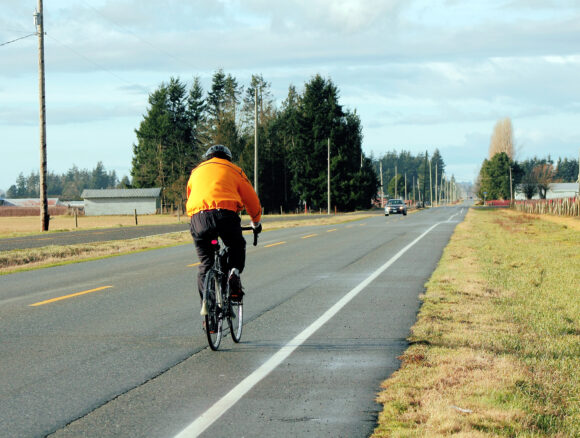While cyclists on Pennsylvania roads must make “reasonable efforts” to not impede the flow of traffic, the law does not mandate that they always and immediately pull off the road to let faster traffic pass, the Pennsylvania Supreme Court recently held in a case of a bicyclist protesting a $25 traffic ticket given him by a state trooper.
The law does require slow-going motor vehicles to pull off the road but whether cyclists should do so is a matter of the circumstances including the road and shoulder conditions, traffic situation, posted speed limits, time of day and other factors.
In a 5-2 opinion, the Pennsylvania Supreme Court disagreed with the Commonwealth, which maintained that the General Assembly imposed on operators of pedalcycles (as they are called in the law) a duty to always and immediately move off the roadway for faster moving traffic.
The high court concluded that the pedalcycle-specific provision of the minimum speed law generally permits operators of pedalcycles to operate “at a safe and reasonable speed appropriate for the pedalcycle” on any highway, regardless of speed limit. However, the provision also mandates that a pedalcycle operator shall use “reasonable efforts so as not to impede the normal and reasonable movement of traffic.”
Brendan Linton was riding his bicycle on Evans City Road in Butler Township. The stretch of roadway in question is a heavily trafficked highway with one westward and one eastward lane. The maximum speed limit varies from 45 miles per hour to 55 mph. There is no minimum speed limit posted.
When a state trooper on patrol, who was aware of complaints of slow moving pedalcycles in the area, pulled onto Evans City Road, there were at least 10 motor vehicles between him and Linton. Within two and a half minutes, all of them successfully passed Linton or turned off the highway, leaving the officer directly behind Linton. The trooper attempted to pass him on the left as they approached an intersection but did not complete the pass of Linton, who was riding at 12 mph in a 45 mph zone. Seconds later, he attempted to pass Linton a second time before again aborting due to oncoming traffic. Linton was traveling at 19 mph at that time, in a 55-mph zone.
The trooper then initiated a traffic stop. Linton was charged with violating the provision on slow speed impeding of traffic and other counts related to providing identification. He proceeded to a summary bench trial.
Between the officer’s two attempted passes, several items appeared in the westbound shoulder within seconds of one another, including: a “Keep Off Shoulder” sign; a moving utility truck with its overhead lights activated; a utility worker walking in front of the truck; and a pedestrian crossing through the shoulder into a commercial driveway. A “Watch for Turns” sign appeared immediately after the trooper attempted the second pass. Also, the trooper specifically “recalled the name Brendan Linton” was associated with “previous encounters of persons exhibiting the same conduct in this area.”
Linton testified that he rides his bicycle almost daily as a form of exercise to treat a chronic medical condition. He characterized the shoulder on the road as “particularly hazardous” and emphasized multiple motor vehicles were able to pass him without him needing to pull off the roadway. When asked whether he took “any efforts to alleviate any motor vehicle traffic behind” him, he responded: “I have no legal obligation to do so.”
Linton argued that the provision requiring vehicles to pull off the side of the road if they are impeding traffic by going slowly does not apply to bicycles or is at least ambiguous.
The Commonwealth maintained the provision does apply unambiguously and that if a “pedalcycle is traveling at such a slow speed that it is impeding traffic, the only practical action for the pedalcycle would be to move off the roadway until traffic subsides.”
The trial court found Linton guilty and imposed a $25 fine. The trial court said Linton “clearly” impeded the normal and reasonable movement of traffic. In the court’s view, he “should have moved to the berm area when motor vehicles were behind him and his failure to do so placed others in grave danger.”
The Superior Court affirmed the trial court’s judgment. This panel said the Commonwealth was required to prove either that the cyclist did not operate at a safe and reasonable speed for a pedalcycle, or that he failed to use reasonable efforts so as not to impede the normal and reasonable movement of traffic. The panel found that the Commonwealth satisfied the latter criteria by establishing that Linton “was impeding traffic on a busy two-lane roadway by traveling in the traffic lane at a speed of 12 mph in a 45-mph zone and 19 mph in a 55-mph zone.” The panel acknowledged there were some obstructions on the berm, but it faulted Linton for “failing to demonstrate why he could not simply go around the single vehicle, the single pedestrian, and the rumble strips, and return to the berm over the remainder of the lengthy stretch of the roadway on which he was travelling.”
The high court took up Linton’s appeal to answer the question:
“Does a proper construction of the code inform the meaning of reasonable efforts and foreclose any interpretation that it includes leaving the roadway whenever faster moving traffic approaches or backs up, which would effectively prohibit operation of pedalcycles on most roadways and/or endanger those operating them throughout the Commonwealth?”
The high court noted that the General Assembly went out of its way to alter the subsection of the vehicle code to make room for the new pedalcycle- specific provision under the regulation titled, “Slow moving vehicle to drive off roadway.” The court said lawmakers did so in a way that does not expressly mandate that pedalcyclists exit the roadway, while also not foreclosing any interpretation of “reasonable efforts” that requires pedalcyclists to leave the roadway.
The court noted that the provision makes “perfect sense” given the typically smaller size of pedalcycles relative to other vehicles, it may be possible to safely pass a relatively small pedalcyclist if it simply moves to the far-right side of the lane, while this would typically be true of other vehicles that merely move to the side.
“The statute appropriately recognizes this distinction by imposing distinct duties, specifically requiring vehicles to exit the roadway but more broadly requiring pedalcycle operators to use ‘reasonable efforts’ consistent with the circumstances. In this way, the General Assembly plainly sought to create additional means for pedalcyclists to alleviate traffic buildup, not to eliminate any.”
The high court reversed the lower courts and remanded the case for further proceedings by the Superior Court to determine whether the evidence was sufficient to prove Linton failed to “use reasonable efforts” to allow traffic to pass.
In making this determination, the high court said the factfinder should consider all relevant factors, including but not limited to: the type of road and number of lanes in each direction; any posted speed minimums or maximums; any posted signage concerning use of the berm or shoulder; the location of the pedalcycle on the roadway; the physical conditions of the roadway; the physical conditions of the berm or shoulder, including whether there are any obstructions thereon; the weather; the time of day; the approximate number of vehicles that have been impeded by the pedalcycle; the average speed of the pedalcycle and the traffic in both directions; the frequency of oncoming traffic; the number of vehicles able to safely pass the pedalcycle; and the average length of time a vehicle is behind the pedalcycle before it is able to safely pass.
Topics Pennsylvania
Was this article valuable?
Here are more articles you may enjoy.



 Litigation Finance Hits a Wall After Bets on Huge Gains Falter
Litigation Finance Hits a Wall After Bets on Huge Gains Falter  Lawsuit Alleges Farm Bureau Financial Concealed Fraudulent Activities
Lawsuit Alleges Farm Bureau Financial Concealed Fraudulent Activities  US E&S Outlook No Longer Positive: AM Best
US E&S Outlook No Longer Positive: AM Best  Lawsuit Over Burger King’s Whopper Ads Set Back by Federal Judge
Lawsuit Over Burger King’s Whopper Ads Set Back by Federal Judge 

